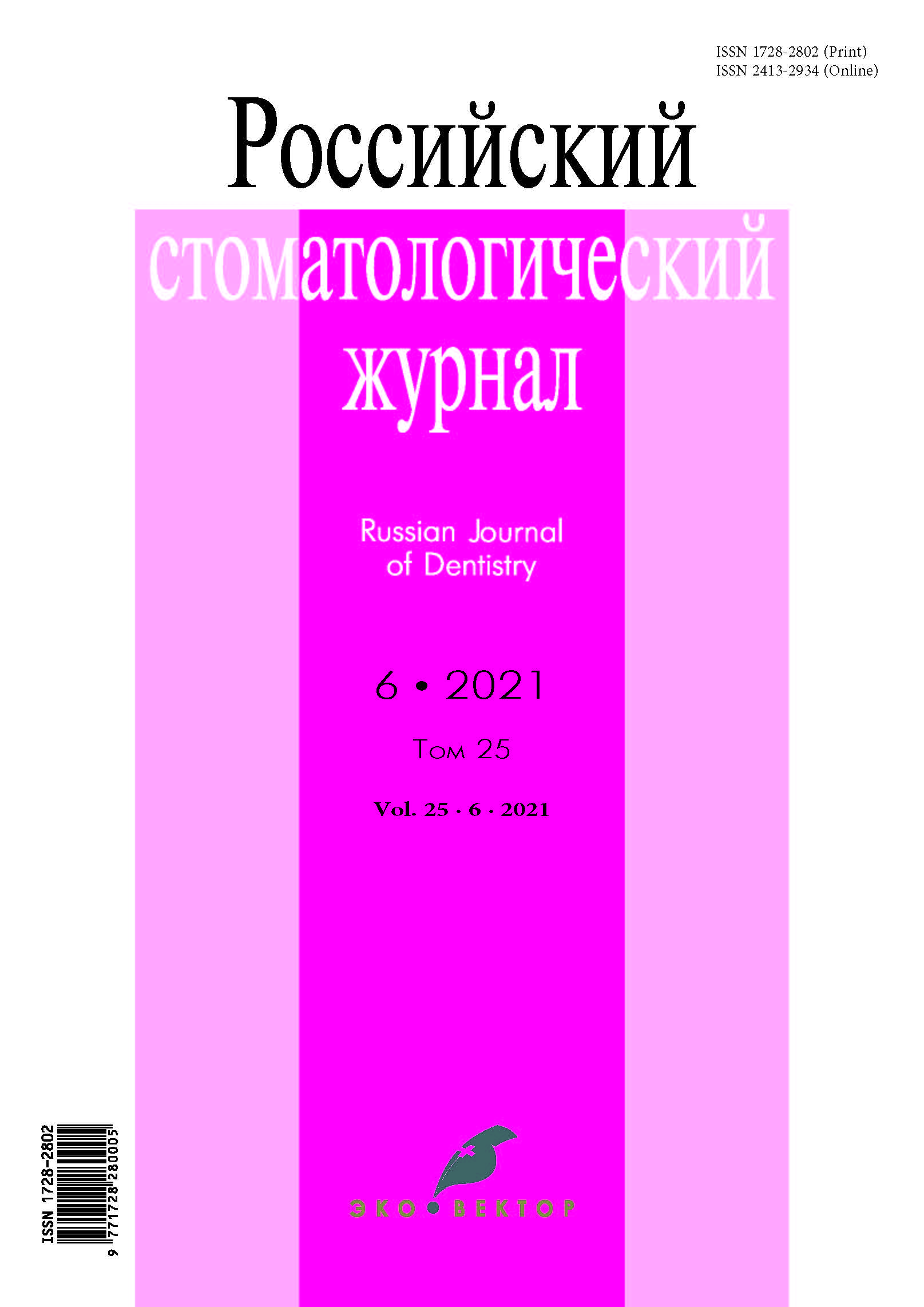Clinical efficiency of the technique for restoring the contact surfaces of the posterior teeth considering the age features
- 作者: Permyakova A.V.1, Nikolayev A.I.1, Monakhova A.N.1, Petrova E.V.1
-
隶属关系:
- Smolensk State Medical University
- 期: 卷 25, 编号 6 (2021)
- 页面: 539-547
- 栏目: Clinical Investigation
- ##submission.dateSubmitted##: 22.07.2022
- ##submission.dateAccepted##: 22.07.2022
- ##submission.datePublished##: 22.07.2022
- URL: https://rjdentistry.com/1728-2802/article/view/109450
- DOI: https://doi.org/10.17816/1728-2802-2021-25-6-539-547
- ID: 109450
如何引用文章
详细
BACKGROUND: Esthetic restoration methods of the posterior teeth using composite materials currently used in dentistry can only be used to create contact in a shape of a point, which does not correspond to the age characteristics of the teeth of adult patients.
AIM: This study aimed to develop and introduce into the dental practice methods for creating and precise positioning of contact pads with size and location that correlated with the patient’s age.
MATERIAL AND METHODS: The quality of restorations of the contact surfaces of the teeth and contact points were assessed considering age characteristics. A total of 289 direct composite restorations of class II (Black) defects that were performed during the treatment of dental caries in 178 patients aged 20–59 years were conducted. The characteristics of 162 Black class II composite restorations performed with modeling contact pads/surfaces using contact formers were compared with the characteristics of 127 Black class II composite restorations performed using the traditional restoration technique.
RESULTS: In the study groups (restorations created using contact formers) 7 days after treatment, restorations were completely in line with the clinical requirements (4 of 4 points) according to the criteria for assessing the quality of the contact surfaces of the teeth and contact pads: 98.3%±1.02% of restorations; after 12 months, 92.5%±2.07%; after 24 months, 74.8%±3.41% of the investigated composite dental restorations. In the comparison groups, the values were as follows: 16.3%±3.28% of restorations (p <0.005); after 12 months, 11.3%±2.81% (p <0.005); and after 24 months, 9.8%±2.64% (p <0.005).
CONCLUSION: The clinical application of the developed technique of contact area modeling during posterior teeth caries treatment, taking into account the age characteristics and using the contact adapter of the original design, makes it possible to improve the quality of the restoration of the contact surfaces of the teeth, contact areas, interdental embrasures, and anatomy of the interdental spaces in general.
全文:
作者简介
Anastasia Permyakova
Smolensk State Medical University
Email: perm_86@list.ru
ORCID iD: 0000-0003-4490-2041
assistant of the department
俄罗斯联邦, 28, Krupskaya str., Smolensk, 214019Alexander Nikolayev
Smolensk State Medical University
编辑信件的主要联系方式.
Email: anicolaev@inbox.ru
ORCID iD: 0000-0002-1378-6538
MD, Dr, Sci. (Med.), professor
俄罗斯联邦, 28, Krupskaya str., Smolensk, 214019Anna Monakhova
Smolensk State Medical University
Email: antonova.a.n@mail.ru
ORCID iD: 0000-0003-1637-2733
assistant of the department
俄罗斯联邦, 28, Krupskaya str., Smolensk, 214019Elena Petrova
Smolensk State Medical University
Email: elena-v-petrova@yandex.ru
ORCID iD: 0000-0002-1869-9409
MD, Cand. Sci. (Med.), associate professor
俄罗斯联邦, 28, Krupskaya str., Smolensk, 214019参考
- Sarig R, Vardimon AD, Sussan C, et al. Pattern of maxillary and mandibular proximal enamel thickness at the contact area of the permanent dentition from first molar to first molar. American Journal of Orthodontics and Dentofacial Orthopedics. 2015;147(4):435–444. doi: 10.1016/j.ajodo.2014.11.026
- Nikolaev AI, Tsepov LM. Practical therapeutic dentistry: textbook: in 3 vol. 10th edition, revised and enlarged. Moscow: MEDpress-inform; 2018. Vol. 1. (In Russ).
- Coulehan JL. The Medical Interview: Mastering Skills for Clinical Practice. 9th edition. California: Davis Company; 2005.
- Vedeneva EV, Gurevich KG, Wagner VD, Fabrikant EG. The relationship between the clinical picture and the quality of life of patients seeking aesthetic dental treatment. Dentistry for All. 2009;(4):4–6. (In Russ).
- Chuang S-F, Su K-C, Wang C-H, Chang C-H. Morphological analysis of proximal contacts in class II direct restorations with 3D image reconstruction. Journal of Dentistry. 2011;39(6):448–456. doi: 10.1016/j.jdent.2011.04.001
- Loomans BAC, Opdam NJM, Roeters FJM, et al. Restoration techniques and marginal overhang in Class II composite resin restorations. Journal of Dentistry. 2009;37(9):712–717. doi: 10.1016/j.jdent.2009.05.025
- Wang Y, Song Y, Zhong Q, Xu C. Evaluation of influence factors on the width, length, and width to length ratio of the maxillary central incisor: A systematic review and meta-analysis. Journal of Esthetic and Restorative Dentistry. 2020;33(2):351–363. doi: 10.1111/jerd.12606
- Lyasova AO. Contact point restoration: the path to success. Bulletin of Medical Internet Conferences. 2017;7(10):1510–1516. (In Russ).
- Nikolaev AI, Tsepov LM. Practical therapeutic dentistry: textbook: in 3 vol. 10th edition, revised and enlarged. Moscow: MEDpress-inform, 2021. Vol. 2. (In Russ).
- Sfondouris T, Prestipino V. Chairside management of an open proximal contact on an implant-supported ceramic crown using direct composite resin. The Journal of Prosthetic Dentistry. 2019;122(1):1–4. doi: 10.1016/j.prosdent.2018.10.019
- Kolodkina VI, Arutyunov AV. Morphological structure of enamel, dentin of teeth and composite filling materials in vitro. Russian Journal of Dentistry. 2018;22(4):176–179. (In Russ).
- Nikolaev AI, Gilmiyarov EM, Mitronin AV, Sadovsky VV. Evaluation criteria for composite dental restorations. Moscow: MEDpress-inform; 2015. (In Russ).
补充文件












